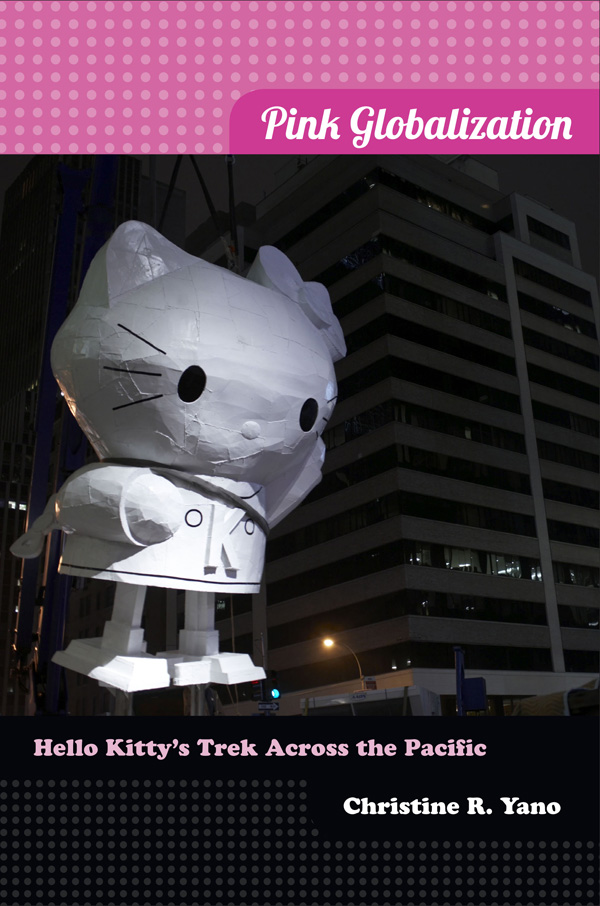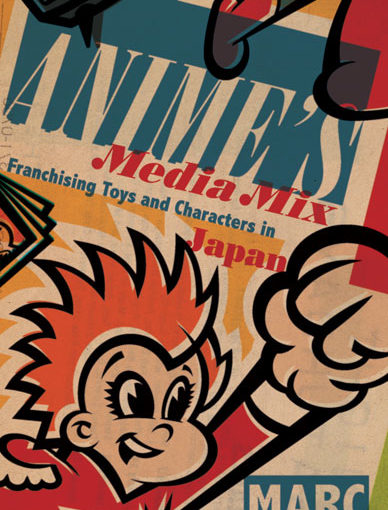Yano, Christine. Pink Globalization. By Christine Yano. Durham, NC: Duke University Press, 2013.
Sayumi Takahashi Harb.
Written in a breezy whirlwind of a conversational style, Christine R. Yano’s Pink Globalization offers the reader a panoramic view of the cultural and anthropological meanings behind Hello Kitty. Though it is not the first book-length treatment of the ubiquitous cat-icon, this contribution is noteworthy for its particularly nuanced treatment of its subject. [1] This is no small feat, given that Hello Kitty has been described mostly as a mere consumer object, and seems designed (in its mute “super-flat”ness) to resist deeply engaging analysis. Yano attempts to decode this deceptively simple character by placing “her” in the context of the globalization of a certain subset of shōjo culture in a post-feminist milieu – what Yano terms “pink globalization,” or “the [recent, post-1970s] transnational spread of goods and images labeled kawaii…from Japan to other parts of the industrial world…” (6).
Yano’s book outlines three “horizons” of the Hello Kitty empire: the domestic realm (i.e. within Japan), the intra-Asian one (such as the cultural flow from Japan to other countries in East, Southeast, South and West Asia), and the global / transcontinental dimension (e.g. transpacific flows to America). Yano devotes one chapter (“Kitty at Home: Kawaii Culture and the Kyarakutaa Business”) to the first horizon. The author provides glimpses of the second horizon in other chapters by mentioning such items and events as Taiwan’s EVA airlines’ Hello Kitty adorned airplanes and the notorious “Hello Kitty murder” in Hong Kong. Overwhelmingly, however, the main focus of the book is on the third horizon, and specifically the proliferation and meanings (or perhaps, proliferation of meanings) of Kitty in the culturally hegemonic territory of the United States. The chapters on Kitty in a global context lay out a parade of reactions to the character amongst people located in the U.S. and Europe, ranging from obsessive hoarding/collecting to alleged pyrotechnic performances of hatred. [2]
Hello Kitty seems both paradigmatic and exceptional in terms of the operations of a gender-coded, soft-power “pink globalization” marked by the multi-mediated spectacle of what Yano terms “Japanese Cute-Cool.” The author notes that Japan’s emergence as “the popular culture hegemon, asserting an alternative Asian-inflected modernity” (14) has coincided with the rise of postfeminism. [3] She exposes this convergence by tracing the transformation of Hello Kitty from “her” genesis in the 1970s to the present; the makeover from a sweetly-drawn character geared towards (mostly girl) children into a versatile icon capable of ironic and playful self-citation addressing multi-generational, complexly gendered consumers at all ends of the spectrum of purchasing power. Yano cites consumer trends forecaster Faith Popcorn’s description of Kitty’s recent appeal for adult women as a “wink on pink” –a mode wherein nostalgic associations with childishness and cloyingly cute femininity are simultaneously evoked and subverted. In this “pink” globalization, traditional Kitty goods are re-vamped in monochrome palettes and use high-end materials to adorn objects targeted at adults (e.g. cars, rice cookers, tablet covers, massage wands): “It’s like saying women are complicated – that we can’t be contained. We can wear monochromatic Armani suits and whip out Hello Kitty notepads at a moment’s notice… a small but very public act of rebellion” (Popcorn, quoted on p. 8).
Pink Globalization cues the reader to question how and to what extent a product of globalized late capitalism can partially signify (or refuse to signify) gendered, sexualized, class-distinguished, and/or ethnic identities. On the one hand, the very success of Hello Kitty lies in the fact that the icon has remained infinitely adaptable, hence resisting any clear identity (e.g. the intentional choice to design “her” as mukokuseki or ‘without nationality’ described on pp. 16-18). On the other hand, Hello Kitty has the power to interpellate the consumer into a specifically defined subject, be it in terms of gender, class, etc.. How exactly does Hello Kitty accomplish this within the ideological multi-state apparati of “pink globalization”?
What is fascinating about Yano’s study is that its pastiche-like analyses reveal the limits of current theoretical approaches towards answering that very question. For example, the author proposes that “the thingness of Hello Kitty rests in the commodity fetishism that surrounds her” (23, my emphasis). And yet this classical Marxist attribution rests on a slippage attributing “thingness” to both object and image (does the “Hello Kitty”ness of Kitty lie in the object for sale? Or the image for sale?). As Bill Brown’s engagements with Thing theory have shown, this slippage or equation is precisely what tautologically glosses over the “Thingness” of the object such that Marxist analysis cannot fully explain the functional meanings of a “Thing” beyond use value and exchange value. [4] This incompleteness within Marx’s theory of commodity fetishism is precisely why Yano intermittently mobilizes affect theory, gift and object theory, theories of “kitsch” and art historical notions of iconicity in an attempt to fill the gap. Of these, affect theory offers much promise in interpreting what is at stake in Kitty’s enduring proliferation around the world. Yano focuses her gaze throughout much of the book on the “kawaii” affective labor done by the product itself or the producers. [5] However, one wonders about the affective labor conducted by consumers and users – might it not be the case with some Hello Kitty fans that what draws them to the winsome cat lies in the fantasy that one does not have to do much of anything (no need to smile, no need to say the right words, no need to invest too much of oneself emotionally, the “cool” part of “Cute-cool”) in order to be so accessibly charming and likeable? Might it not be the case that Hello Kitty represents for such consumers not so much an ideal “object” on which to exercise “sentimental [maternal] materialism” (Lori Merish), but rather an ideal subject to be, as Yano tantalizingly suggests in quoting Sharon Kinsella in Chapter One, “Kitty at Home”: “Cute fashion in Japan was more than mere cuddling cute things; it was all about ‘becoming’ the cute object itself” (56). Given the extent to which the economy of a pink-globalized world is service-oriented, wouldn’t looking at the affective labor of service-providers-turned-Kitty consumers be worthy of further study (indeed, Yano mentions cases of sex workers who are Hello Kitty fans)?
Furthermore, the aforementioned issue of identification seems key even in contexts outside of Japan, given that the iconicity of Hello Kitty is designed precisely to allow for increased identification between the viewer/consumer and the character – as Scott McCloud has shown in the case of comics, the more simply and schematically drawn and “iconic” a given character is, the greater the ability of the viewer to relate to that character. [6] In this vein, Yano’s book may have benefitted both from a consideration of psychoanalytic approaches to cathexis (cat-hexis?) and a discussion about Hello Kitty’s relation to other softpower cultural exports from Japan (mainly manga and anime). How does Hello Kitty, for example, relate to the larger cultural practice of producing/playing with gijinka (prosopopoetic) characters that comprise a major part of the circulation of moe images? How does Kitty fit into a theory of prosopopoeia more generally, and how does this relate to Yano’s own explanation of Kitty as functioning as “migawari (self-other exchange, surrogacy)” (64)? Moreover, given the timing of Hello Kitty’s genesis in the 1970s when the “49ers” of shōjo comics came to the fore, the project may have gained a cultural insight from a more sustained engagement with these other forms of shōjo culture. Still, Yano’s work provides a complex account of how this Japanese commodity character evolved through gifting practices into a (pink) global phenomenon. And her book will be useful in the classroom, especially for lessons on Japanese popular culture. The text, for example, raises questions such as: To what extent does Hello Kitty operate as a neo-Orientalist “sub-empire of signs” as Toshiya Ueno has described the phenomenon of anime’s spread to the United States and other Western countries? [7] Instructors may also use this work to question the explanatory reach and power of gender and queer theory in unpacking this particular cat icon – how does one explain the appeal of Hello Kitty to certain fans (mentioned in the book) who are male, not necessarily homosexual, and somehow slightly “closeted” about their attraction to this character?
In summary, Pink Globalization is an ambitious undertaking that deftly lays out many of the fascinating contradictions behind the Hello Kitty icon and its meanings. The book leaves us wondering: what exactly are the underlying power structures that enable (and are enabled by) Kitty’s success around the world? What we are left with at the end is a complex, oscillating stereoscope of the icon. Yano clearly exposes its subversive nature, while also inciting us to consider how “cute” Hello Kitty’s ideological work exactly is, in our contemporary world order dominated by the power of multi-national corporations and transnational corporations such as Sanrio. For as Masao Miyoshi described in his seminal article, “A Borderless World? From Colonialism to Transnationalism and the Decline of the Nation-State,” what on the surface appears as a shifting decolonization may actual be a form of recolonization under a different name or face – how might “pink globalization” relate to “pinkwashing” for example? [8] The book thus turns this seemingly innocuous commodity into a cultural symbol imbued with multiple significations. In this manner, Yano opens up the important question of how to re-think the political economy of gifting in late capitalist globalization, and the ways in which affect and money operate in this new order of emotional engineering.
Sayumi Takahashi Harb is Assistant Professor of Japanese Literature at Connecticut College. http://www.conncoll.edu/directories/faculty-profiles/sayumi-harb/.
[1] Ken Belson and Brian Bremner’s 2003 volume entitled Hello Kitty: The Remarkable Story of Sanrio and the Billion Dollar Feline Phenomenon had revealed the marketing strategies behind Sanrio’s success in making the character globally popular, but did so in a manner that regrettably reprised numerous Orientalist tropes and stereotypes.
[2] The “Terms of Service” page for the Landover Baptist Church website states in white letters at the bottom (in the “Spoiler Alert” section) that “The Landover Baptist Church is a complete work of fiction. It is a satire/parody.” http://www.landoverbaptist.org/tos.html (accessed July 14, 2013). This must be an oversight on the part of the author and the editors at Duke University Press, but one that does not detract greatly from the main thrust of the book. In fact, the satirical webpage acutely dramatizes an aspect of what Hello Kitty may represent abroad – multiculturalism as mediated and diffused by neoliberal and capitalist considerations via a society of the spectacle (e.g. celebrity feminism as described by Jennifer Wicke “Celebrity Material: Materialist Feminism and the Culture of Celebrity,” in Feminism, the Public and the Private, ed. Joan B. Landes (New York: Oxford Univ. Press, 1998).
It is no surprise, therefore, that Yano channels Baudrillard quite heavily in this section, and gives voice to a number of Hello Kitty fans who are also marginalized (by race, age, sexual preference, etc.) within the mainstream culture of the U.S. Thus, much of this book could be read productively in a course on American and/or Asian American Studies as well.
The text could be also used in a curriculum in graphic arts and/or animation studies. In the introduction, Yano gives a concise history of the color “pink” in American culture. Readers should note that there is a slight omission of a potentially important precedent or model or “pink as cool” in America: Peter Sellers’ The Pink Panther – the Pink Panther would be a fascinating point of cross-cultural comparison and contrast. The ultimate challenge in a classroom outside of Japan would be to unpack for students and wider audiences the meanings of certain Japanese terms such as asobi (play), mitate (figurative language imbued with intertextuality), and the aforementioned migawari, which Yano fruitfully mobilizes to explain the cultural origins of this bowed and mouthless cat.
[3] Though Yano does not explicitly define how she is deploying this term in her book, my reading of “postfeminism” in Pink Globalization is that it does not signify “anti-feminism” or the sense that second-wave feminist concerns have somehow been met and therefore obsolete. Rather, I see Yano’s citation of postfeminism as pointing to an ever-evolving, image-conscious, self-parodying, self-fashioning mode of feminist critique as it overlaps with late capitalism and global circulation of images in contemporary (specifically post-1970s) postmodernity.
[4] Bill Brown, A Sense of Things: The Object Matter of American Literature (Chicago: University of Chicago Press, 2003).
[5] See, for example, Yano’s assertion that “the affective labor of Sanrio’s cat draws fans in close as one with whom they may share freely and unconditionally. This is one friend who will never leave them or talk back” (162).
[6] Scott McCloud, Understanding Comics: The Invisible Art (New York: William Morrow, 1993).
[7] Ueno Toshiya, “Japanimation and Techno-Orientalism,” in The Uncanny: Experiments in Cyborg Culture, edited by Bruce Grenville (Arsenal Pulp Press, 2002), pp. 223-231 .
[8] Masao Miyoshi, “A Borderless World? From Colonialism to Transnationalism and the Decline of the Nation-State,” Critical Inquiry 19, no. 4 (Summer 1993): 726-751.




